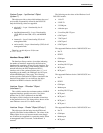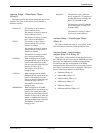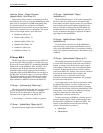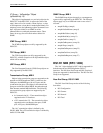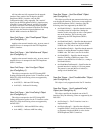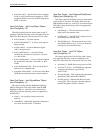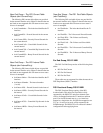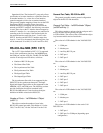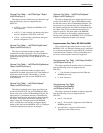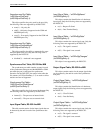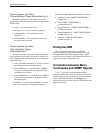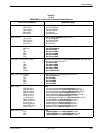
ACCULINK 316x DSU/CSU
E-10 January 1997 3160-A2-GB21-50
• dsx1LineLoop(3) – Specifies that a Line Loopback
(LLB) is active for the network interface or a DTE
Loopback (DLB) is active for the DTE Drop/Insert
(DSX-1) interface.
Near End Group – “dsx1LineStatus” Object
(dsx1ConfigEntry 10)
This object specifies the line (alarm) status of the T1
interfaces. Only the following values are supported by the
DSU/CSU. More than one value may be active at a time.
• dsx1NoAlarm(1) – No alarm present.
• dsx1RcvFarEndLOF(2) – A yellow alarm signal is
being received.
• dsx1RcvAIS(8) – An Alarm Indication Signal
(AIS) is being received.
• dsx1LossOfFrame(32) – An Out Of Frame
condition has persisted for more that 2.5 seconds
(i.e., Red Alarm).
• dsx1LossOfSignal(64) – A Loss of Signal condition
has persisted for more that 2.5 seconds (i.e., Red
Alarm).
• dsx1LoopbackState(128) – The near end of the T1
interface is in a loopback state.
• dsx1Other Failure(4096) – An Excessive Error Rate
(EER) has been detected on the network interface.
Near End Group – “dsx1SignalMode” Object
(dsx1ConfigEntry 11)
This object specifies whether Robbed Bit Signaling
(RBS) is being used. This object differs from the MIB
definition in that it is “read-only” (not read/write) for
DSU/CSUs. Only the following values are supported by
the DSU/CSU.
• none(1) – No signaling is being used on this
interface.
• robbedBit(2) – Robbed Bit Signaling is being used
on at least one DS0 on this T1 interface.
Near End Group – “dsx1TransmitClockSource”
Object (dsx1ConfigEntry 12)
This object specifies the timing source for the transmit
clock for this T1 interface. This object differs from the
MIB definition in that it is “read-only” (not read/write) for
DSU/CSUs. Only the following values are supported by
the DSU/CSU.
• loopTiming(1) – The recovered receive clock is
being used as the transmit clock.
• localTiming(2) – The DSU/CSU’s internal clock is
used being as the transmit clock.
• ThroughTiming(3) – The recovered receive clock
from another interface (e.g., T1, Port, or External)
is being used as the transmit clock.
Near End Group – “dsx1Fdl” Object
(dsx1ConfigEntry 13)
This object specifies how Facility Data Link is being
used. Only the following values are supported by the
DSU/CSU. More than one value may be active at a time.
• dsx1other(1) – SNMP data is being sent over FDL.
• dsx1Ansi-T1-403(2) – ANSI PRMs are supported
on the network interface as specified by
ANSI T1.403.
• dsx1Att-54016(4) – FDL supports the requirements
specified by AT&T publication TR54016.
• dsx1Fdl-none(8) – Indicates that the device does
not use FDL. This is the only value that applies to
the DTE Drop/Insert (DSX-1) interface.




